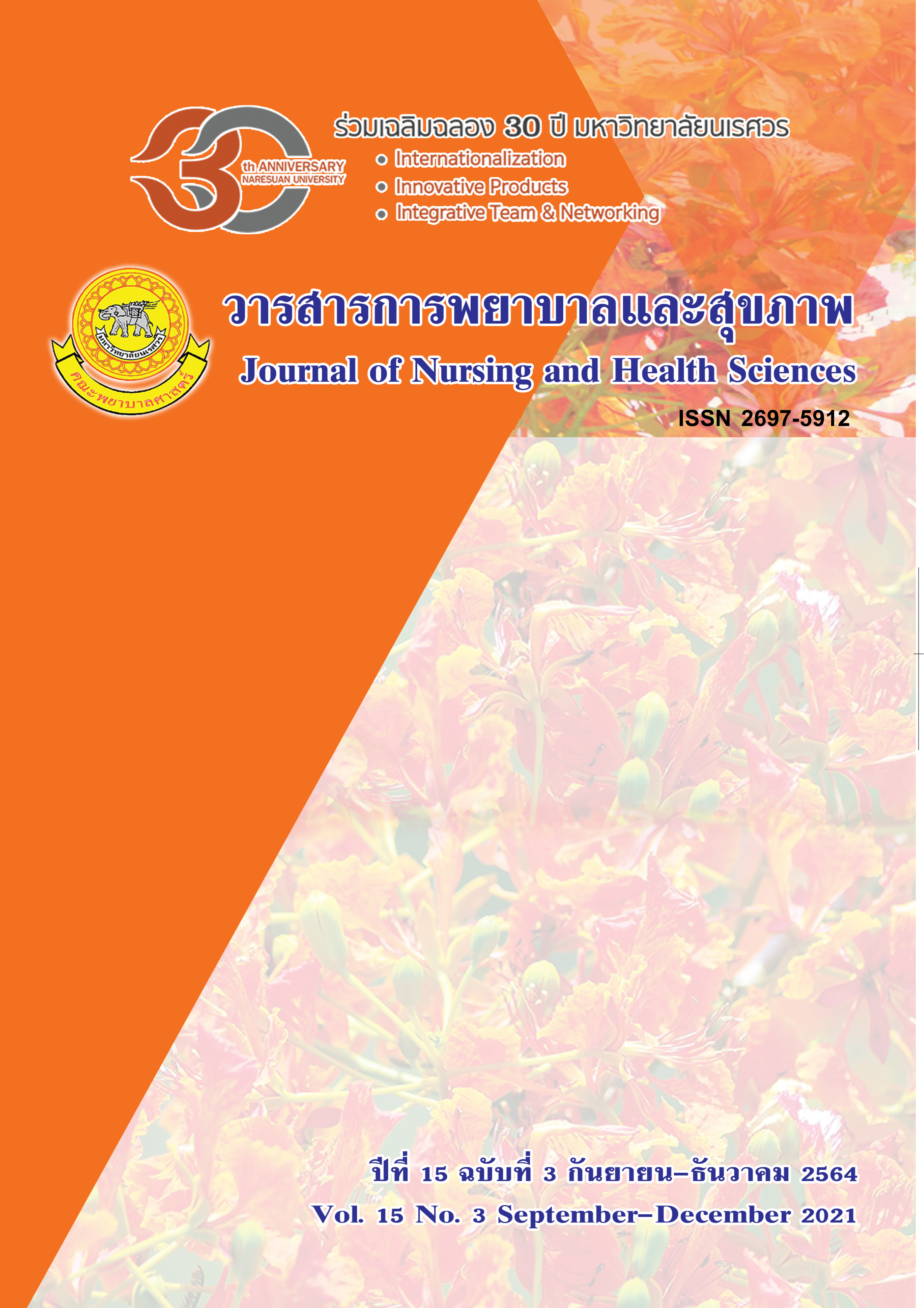ปัจจัยที่มีความสัมพันธ์กับผลการปฏิบัติงานของพยาบาลวิชาชีพใหม่ในโรงพยาบาลเอกชน
Main Article Content
บทคัดย่อ
ผลการปฏิบัติงาน (Job performance) ของพยาบาลเป็นพฤติกรรมที่นำไปสู่ผลลัพธ์ที่มีประสิทธิผลขององค์กรพบว่า มีปัจจัยที่มีความสัมพันธ์กับผลการปฏิบัติงาน การวิจัยเชิงปริมาณแบบการศึกษาความสัมพันธ์ การวิจัยนี้ มีวัตถุประสงค์เพื่อศึกษาปัจจัยที่มีความสัมพันธ์กับผลการปฏิบัติงานของพยาบาลใหม่ในโรงพยาบาลเอกชน จำนวนตัวอย่าง 163 ราย สุ่มตัวอย่างด้วยวิธีแบ่งชั้น (Stratified random sampling) เก็บรวบรวมข้อมูลด้วยแบบสอบถาม มี 4 ส่วน วิเคราะห์คุณภาพของแบบสอบถาม ได้ค่าดัชนีความตรง เท่ากับ 0.98 ,1, 0.96 และค่าความเที่ยงด้วยสัมประสิทธ์แอลฟาของครอนบาคโดยรวม เท่ากับ 0.95 วิเคราะห์ข้อมูลด้วยสถิติเชิงพรรณนา จำนวน ร้อยละ ค่าเฉลี่ยและส่วนเบี่ยงเบนมาตรฐาน ใช้สถิติทดสอบความสัมพันธ์แบบเพียร์สัน (Pearson’s product moment correlation)
ผลการวิจัย พบว่า ภาวะผู้นำการเปลี่ยนแปลงของหัวหน้าหอผู้ป่วยมีความสัมพันธ์เชิงบวกในระดับปานกลางกับผลการปฏิบัติงานของพยาบาลใหม่ในโรงพยาบาลในโรงพยาบาลเอกชน อย่างมีนัยสำคัญทางสถิติที่ระดับ .05 (r = .54) การเสริมสร้างพลังอำนาจในงานของหัวหน้าหอผู้ป่วยกับผลการปฏิบัติงานของพยาบาลใหม่ มีความสัมพันธ์เชิงบวกในระดับปานกลาง อย่างมีนัยสำคัญทางสถิติที่ระดับ .05 (r = .57) การวิจัยนี้ชี้ให้เห็นว่า ภาวะผู้นำของผู้บริหารทางการพยาบาล มีความสำคัญกับผลการปฏิบัติงาน โดยเฉพาะการส่งเสริมพลังอำนาจ ด้านการพัฒนาทักษะในด้านการส่งต่อข้อมูล รูปแบบในการสื่อสาร พร้อมการส่งเสริมการพัฒนาผู้จัดการแผนก/หัวหน้าแผนก/หัวหน้าเวร ผลการปฏิบัติงานเป็นแรงจูงใจ ให้พยาบาลวิชาชีพพัฒนาตนเองและเตรียมพร้อมในการเข้าสู่ตำแหน่งที่สูงขึ้นต่อไป
คำสำคัญ: ผลการปฏิบัติงานของพยาบาลใหม่, ภาวะผู้นำการเปลี่ยนแปลง, การเสริมสร้างพลังอำนาจ
* Corresponding author: Jimmaree Uppahad: email: Jimmareeuppahad@gmail.com
* นักศึกษาพยาบาลศาสตรมหาบัณฑิต (การบริหารการพยาบาล) คณะพยาบาลศาสตร์ มหาวิทยาลัยคริสเตียน
** ศาสตราจารย์ คณะพยาบาลศาสตร์ มหาวิทยาลัยคริสเตียน
*** ผู้ช่วยศาสตราจารย์ คณะพยาบาลศาสตร์ มหาวิทยาลัยคริสเตียน
**** อาจารย์คณะพยาบาลศาสตร์ มหาวิทยาลัยคริสเตียน
Article Details

อนุญาตภายใต้เงื่อนไข Creative Commons Attribution-NonCommercial-NoDerivatives 4.0 International License.
เอกสารอ้างอิง
Almutairi, D. O. (2015). The mediating effects of
organizational commitment on the relationship
between transformational leadership style and job
performance. International Journal of Biometrics,
, 231.
Bass, B. M., & Avolio, B. J. (1994). Transformational
leadership development. Pola Alto, California:
Consulting Psychogists.
Bass, B. M. (1990). From transactional to transformational
leadership: Learning to share the vision.
Organizational Dynamics, 18(3), 19-31.
Bass, B., & Riggio, E. (2006). Transformational leadership.
Mahwah, NJ: Lawrence Erlbaum Associates.
Bell. (2013).Five generations in the nursing workforce:
Implications for nursing professional development.
Journal of Nurses Professional Development
; 29: 205-210.
Benner, P. (1984). Form novice to expert: Excellence
and power in clinical nursing practice. Menlo
Park, CA: Addison-Wesley.
Best, J. W., & Kahn, J. V. (2016). Research in Education
(10th ed.). New York: Pearson.
Borman, W. C., & Motowidlo, S.J. (1993). Expanding
the criterion domain to include elements of
contextual performance. In N. Schmitt & W. C.
Borman, (ed.), Personnel selection in
organizations. San Francisco: Jossey-Bass.
Burns, N., & Grove, S. K. (2001). The practice of nursing
research, conduct, critique, and utilization (4thed.).
Philadelphia: W.B. Saunders.
Dawudom1, N., Tunyapalit1, S., Sookmak, A., &
Chaleoykitti, S. (2016). ThamonpatSimakorn.
The Development of Nursing’s Mentorship
Model at Phramongkutklao Hospital. Journal
of The Royal Thai Army Nurses, 17(3), 197-206.
[In Thai].
Greenslade, J. H., & Jimmieson, N. L. (2007).
Distinguishing between task and contextual
performancefor nurses: development of a job
performance scale. Journal of Advanced
Nursing, 58(6),602-611.
Gupta, K. K., Attri, J. P., Singh, A., Kaur, H., & Kaur, G.
(2016). Basic concepts for sample size calculation: Critical step for any clinical trials. Saudi
Journal of Anesthesia, 10, 328-331.
Ibrahim SAEl-A, Ibrahim El Sayed R, Attala MM, &
Elmezin NK. (2016). Relationship between head
nurses' leadership styles and staff nurses' job
performance. IOSR-JNHS, 5(1), 66-74.
Jyoti, J., & Bhau, S. (2015). Impact of transformational
leadership on job performance: mediating
role of leader-member exchange and relational
identification. SAGEOpen, 15(4), 1-13. Doi: 10.
/2158244015612518
Kanter, R. M. (1977). Men and women of the corperation.
New York: Basic Books.
Koopmans, L. (2014). Measuring individual work
performance. Zutphen: CPI Koninklijke Wohrmann.
Kruschke, C. (2016). Generation Z is coming to the
workforce: Are you prepared to attract, train,
and retain thisgeneration of nurses? Retrieved
November 2018 from https://greatplainsqin.org/
gpqcc/wpcontent/uploads/sites/5/2016/03/Handouts-Generation-Z-is-Coming-go-the-WorkForce.pdf
Kuewong, G., & Oumtanee, A. (2017). Stress of newly
graduated nurses working at an intensive care
unit. Journal of The Royal Thai Army Nurses,
(Supplement), 158-165.[In Thai].
Kuokkanen, L. (2014). Does organizational justice
predict empowerment? Nurses assess their work
environment. Journal of Nursing Scholarship,
(5), 349-356.
Laschinger, H. K. S., Finegan, J., & Shamian J. (2001).
Impact of structural and psychological empowerment on job strain in nursing work settings.
Expanding Kanter's Model. Journal of Nursing
Administration, 1, 260-272. http://dx.doi.org/10.
/00005110-200105000-00006.
Marquis, B. L., & Huston, C. J. (2012). Leadership
roles and management functions in nursing:
Theory and application (7th ed.). Philadelphia,
PA: R. R. Donnelley Crawfordsville.
SilaMom, B., Deewisaret, W., & Khamyu, A. (2018).
Factor influencing the retention of generation Y
professional nurse at a hospital. Journal of
Nursing and Health Care, 36(1), 62-71. [In Thai].
Songsraboon, R. (2014). Model of an excellent service
of private hospitals in Thailand. Journal of
Graduate School of Commerce Burapha Review,
(2), 54-67. [In Thai].
Sriboonwong, L., Singchangchai, P., & Aree, P. (2020).
The relationship model among transformational
leadership of head nurses, innovative work
behavior and task performance as perceived by
professional nurses in general hospitals. Thai
Journal of Cardio-Thoracic Nursing, 31(2), 96-
[In Thai].
Srisathidnarakur B. (2010). The methodology in nursing
research(5th ed.). Bangkok: Printing house
You and I Inter Media Company. [In Thai].
Sukcharoen, Y.,&Klumrat, K. (2015). Factors related to
the job performance competency among
registered nurses in Sub-district health promotion
hospitals, NakhonPathom Province. Princess of
Naradhiwas University Journal, 2(2), 14-26.
[In Thai].
Voraakom, V. (2014). 5 Insight generation Z. Krungthep
Turakij. Retrieved dd/mm/yy from https://www.
bangkokbiznews.com/blog/detail/591770.
[In Thai].
Waiyakorn, R., Singchungchai, P., & Puthiaungkul,
B. (2019). The relationships between the
participatory management work empowerment,
and the effectiveness of patient unit as perceived
by First- Line nurse managers, Private Hospitals.
Nursing Journal, 46(2), 142-151. [In Thai].
Wong & Laschinger. (2012).Authentic leadership,
performance, and job satisfaction: the mediating
role of empowerment. Journal of Advanced
Nursing, 69(4), 947-959.
Wongcharoen, W., Singchungchai, P., Wongkhomthong,
J., & Meehanpong, P. (2018). The structural
equation model of leadership of In-Patient Unit
head nurses as perceived by professional nurses,
nurses' work engagement, and job performance
of professional nurses in community hospitals.
Journal of The Royal Thai Army Nurses, 19(3),
-106.[In Thai].


